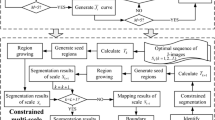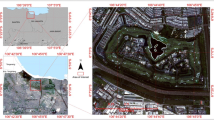Abstract
As the remote sensing technology develops, there are increasingly more kinds of remote sensing images available from different sensors. High-resolution remote sensing images are widely used in the detection of land cover/land change due to their plenty of characteristics of a specific feature in terms of spectrum, shape, and texture. Current studies regarding cultivated land resources that are the material basis for the human beings to survive and develop focus on the method to accurately obtain the quantity of cultivated land in a region and understand the conditions and the trend of change of the cultivated land. Pixel-based method and object-oriented method are the main methods to extract cultivated land in remote sensing field. Pixel-based method ignores high-level image information, while object-oriented method takes the image spot after image segmentation as the basic unit of information extraction, which can make full use of spectral features, spatial features, semantic features, and contextual features. Image segmentation is a key step of object-oriented method; the core problem is how to obtain the optimal segmentation scale. Traditional methods for determining the optimal segmentation scale of features (such as the homogeneity-heterogeneity method, the maximum area method, and the mean variance method), in which only the spectral and geometrical characteristics are considered, while the textural characteristics are neglected. Based on this, the Quickbird and unmanned aerial vehicle (UAV) images obtained in Xiyu Village, Pengzhou City, Sichuan Province, China, were selected as experimental objects, and the texture mean and spectral grayscale mean method (MANC method based on GLCM), which comprehensively considered the spectrum, shape, and texture features, was proposed to calculate the optimal segmentation scale of cultivated land in the study area. The error segment index (ESI) and centroids distance index (CDI) were adopted to evaluate image segmentation quality based on the method of area and position differences. The experimental results show that the MANC method based on GLCM can obtain higher segmentation precision than the traditional methods, and the segmentation results are in good agreement with the cultivated land boundary obtained by visual interpretation.








Similar content being viewed by others
Data availability
All the data and materials related to the manuscript are published with the paper, and available from the corresponding author upon request (lilongguo@scu.edu.cn).
References
Addink EA, Jong SMD, Pebesma EJ (2007) The importance of scale in object-based mapping of vegetation parameters with hyperspectral imagery. Photogramm Eng Remote Sens 73(8):905–912
Baraldi A, Parmiggiani F (1995) Investigation of the textural characteristics associated with gray level cooccurrence matrix statistical parameters. IEEE Trans Geosci Remote Sens 33(2):293–304
Belgiu M, Tomljenovic I, Lampoltshammer TJ, Blaschke T, Höfle B (2014) Ontology-based classification of building types detected from airborne laser scanning data. Remote Sens 6(2):1347–1366
Benediktsson JA, Chanussot J, Moon WM (2013) Advances in very-high-resolution remote sensing [scanning the issue]. Proc IEEE 101(3):566–569
Benediktsson JA, Palmason JA, Sveinsson JR (2005) Classification of hyperspectral data from urban areas based on extended morphological profiles. IEEE Trans Geosci Remote Sens 43(3):480–491
Benz, Ursula C, HOFMANN, Peter, WILLHAUCK, Gregor, et al(2004). Multi-resolution, object-oriented fuzzy analysis of remote sensing data for GIS-ready information. ISPRS J Photogramm Remote Sens 58(3):239-258.
Blaschke T (2010). Object based image analysis for remote sensing. Isprs J Photogramm Remote Sens. 65(1):2-16.
Blaschke T, Hay GJ, Kelly M, Lang S, Hofmann P, Addink E et al (2014) Geographic object-based image analysis-towards a new paradigm. ISPRS-J Photogramm Remote Sens 87:180–191
Chan JCW, Laporte N, Defries RS (2003) Texture classification of logged forests in tropical Africa using machine-learning algorithms. Int J Remote Sens 24(6):1401–1407
Cheng J, Bo Y, Zhu Y, Ji X (2014). A novel method for assessing the segmentation quality of high-spatial resolution remote-sensing images. International Journal of Remote Sensing. 35(10):3816-39.
Clinton N, Holt A, Scarborough J, Li Y, Peng G (2010) Accuracy assessment measures for object-based image segmentation goodness. Photogramm Eng Remote Sens 76(3):289–299
Coburn CA, Roberts ACB (2004) A multiscale texture analysis procedure for improved forest stand classification. Int J Remote Sens 25(20):4287–4308
Conchedda G, Durieux L, Mayaux P (2008) An object-based method for mapping and change analysis in mangrove ecosystems. ISPRS J Photogramm Remote Sens 63(5):578–589
Darling EM, Joseph RD (1968) Pattern recognition from satellite altitudes. IEEE Trans Syst Sci Cybern 4(1):38–47
Dorren LKA, Maier B, Seijmonsbergen AC (2003) Improved Landsat-based forest mapping in steep mountainous terrain using object-based classification. Forest Ecol Manag 183(1):31–46
Dragut L, Csillik O, Eisank C, Tiede D (2014) Automated parameterisation for multi-scale image segmentation on multiple layers. ISPRS-J Photogramm Remote Sens 88:119–127
Draguţ L, Tiede D, Levick SR (2010) ESP: a tool to estimate scale parameter for multiresolution image segmentation of remotely sensed data. Int J Geogr Inf Sci 24(6):859–871
Esch T, Thiel M, Bock M, Roth A, Dech S (2008) Improvement of image segmentation accuracy based on multiscale optimization procedure. IEEE Geosci Remote Sens Lett 5(3):463–467
Espindola GM, Camara G, Reis IA, Bins LS, Monteiro AM (2006) Parameter selection for region-growing image segmentation algorithms using spatial autocorrelation. Int J Remote Sens 27(14):3035–3040
Flanders D, Hall-Beyer M, Pereverzoff J (2003) Preliminary evaluation of eCognition object-based software for cut block delineation and feature extraction. Can J Remote Sens 29(4):441–452
Franklin SE, Maudie AJ, Lavigne MB (2001) Using spatial co-occurrence texture to increase forest structure and species composition classification accuracy. Photogramm Eng Remote Sens 67(7):849–855
Grybas H, Melendy L, Congalton RG (2017) A comparison of unsupervised segmentation parameter optimization approaches using moderate- and high-resolution imagery. Gisci Remote Sens 54(4):1–19
Haralick RM, Shanmugam K, Dinstein I (1973) Textural features for image classification. IEEE Trans Syst Man Cybern SMC-3(6):610–621
Johansen K, Arroyo LA, Phinn S, Witte C, Hay GJ, Blaschke T (2010) Comparison of geo-object based and pixel-based change detection of riparian environments using high spatial resolution multi-spectral imagery. Photogramm Eng Remote Sens 76(2):123–136
Johnson B, Xie Z (2011) Unsupervised image segmentation evaluation and refinement using a multi-scale approach. ISPRS J Photogramm Remote Sens 66(4):473–483
Jun Z, Guolong Z, Yan L (2011) An algorithm based on Kalman filtering for estimating kinematic model errors. Sci Survey Mapp 36(2):107–109
Kim M, Warner TA, Madden M, Atkinson DS (2011) Multi-scale GEOBIA with very high spatial resolution digital aerial imagery: scale, texture and image objects. Int J Remote Sens 32(10):2825–2850
Kuffer M, Pfeffer K, Sliuzas R, Baud I (2016) Extraction of slum areas from VHR imagery using GLCM variance. IEEE J Selected Topics Appl Earth Obs Remote Sens 9(5):1830–1840
Laliberte AS, Rango A, Havstad KM, Paris JF, Beck RF, Mcneely R et al (2004) Object-oriented image analysis for mapping shrub encroachment from 1937 to 2003 in southern New Mexico. Remote Sens Environ 93(1):198–210
Lathrop RG, Montesano P, Haag S (2006) A multi-scale segmentation approach to mapping seagrass habitats using airborne digital camera imagery. Photogramm Eng Remote Sens 72(6):665–675
Lucieer A, Stein A (2002) Existential uncertainty of spatial objects segmented from satellite sensor imagery. IEEE Transactions on Geoscience & Remote Sensing. 40(11):2518–2521
Martha TR, Kerle N, Westen CJV, Jetten V, Kumar KV (2011) Segment optimization and data-driven thresholding for knowledge-based landslide detection by object-based image analysis. IEEE Transactions on Geoscience & Remote Sensing. 49(12):4928–4943
Mathieu R, Freeman C, Aryal J (2007) Mapping private gardens in urban areas using object-oriented techniques and very high-resolution satellite imagery. Landsc Urban Plan 81(3):179–192
Maxwell TL, Yun Z(2005). A fuzzy approach to supervised segmentation parameter selection for object-based classification. Proceedings of the SPIE - The International Society for Optical Engineering. 5909(1):590910-1-11.
Molenaar M (2005). Quality assessment for geo-spatial objects derived from remotely sensed data. International Journal of Remote Sensing. 26(14):2953-74.
Möller M, Lymburner L, Volk M (2007) The comparison index: a tool for assessing the accuracy of image segmentation. Int J Appl Earth Obs Geoinf 9(3):311–321
Momeni R, Aplin P, Boyd DS (2016) Mapping complex urban land cover from spaceborne imagery: the influence of spatial resolution, spectral band set and classification approach. Remote Sens 8(2):88
Qian Y, Peng G, Clinton N, Biging G, Kelly M, Schirokauer D (2006) Object-based detailed vegetation classification with airborne high spatial resolution remote sensing imagery. Photogramm Eng Remote Sens 72(7):799–811
Ryherd S, Woodcock CE (1996) Combining spectral and texture data in the segmentation of remotely sensed images. Photogramm Eng Remote Sens 62(2):181–194
Shackelford AK, Davis CH(2003). A combined fuzzy pixel-based and object-based approach for classification of high-resolution multispectral data over urban areas. IEEE Transactions on Geoscience and Remote Sensing. 41(10 PART I):2354-63.
Shen L, Wu L, Dai Y, Qiao W, Wang Y (2017) Topic modelling for object-based unsupervised classification of VHR panchromatic satellite images based on multiscale image segmentation. Remote Sens 9(8)
Uuemaa E, Roosaare J, Mander U (2005) Scale dependence of landscape metrics and their indicatory value for nutrient and organic matter losses from catchments. Ecol Indic 5(4):350–369
Witharana C, Civco DL, Meyer T H (2014). Evaluation of data fusion and image segmentation in earth observation based rapid mapping workflows Isprs J Photogramm Remote Sens 87(2014):1-18.
Xiong X, Zhong Y, Zhang L, Zhang H (2013) Sub-pixel mapping based on a MAP model with multiple shifted hyperspectral imagery. IEEE J Selected Topics Appl Earth Obs Remote Sens 6(2):580–593
Yan G, Mas JF, Kerle N, Pacheco JAN (2011) Optimal region growing segmentation and its effect on classification accuracy. Int J Remote Sens 32(13):3747–3763
Zhang H, Fritts JE, Goldman SA (2008) Image segmentation evaluation: a survey of unsupervised methods. Comp Vision Image Underst 110(2):260–280
Zhang X, Feng X, Xiao P, He G, Zhu L (2015) Segmentation quality evaluation using region-based precision and recall measures for remote sensing images. ISPRS J Photogramm Remote Sens 102:73–84
Zhong Y, Wang X, Zhao L, Feng R, Zhang L, Xu Y(2016). Blind spectral unmixing based on sparse component analysis for hyperspectral remote sensing imagery. Isprs Journal of Photogrammetry & Remote Sensing 119:49-63.
Funding
This research was supported by the National Natural Science Foundation of China (41701499), the Sichuan Science and Technology Program (2018GZ0265), and the Geomatics Technology and Application Key Laboratory of Qinghai Province (QHDX-2018-07).
Author information
Authors and Affiliations
Contributions
Lu H drafted the manuscript and was responsible for the research design, experiment, and analysis. Li LG reviewed and edited the manuscript. Liu C, Li NW, and Fu X supported the data preparation and the interpretation of the results. All of the authors contributed to editing and reviewing the manuscript.
Corresponding author
Ethics declarations
Competing interests
The authors declare that they have no conflict of interest.
Additional information
Responsible Editor: Philippe Garrigues
Publisher’s note
Springer Nature remains neutral with regard to jurisdictional claims in published maps and institutional affiliations.
Rights and permissions
About this article
Cite this article
Lu, H., Liu, C., Li, N. et al. Optimal segmentation scale selection and evaluation of cultivated land objects based on high-resolution remote sensing images with spectral and texture features. Environ Sci Pollut Res 28, 27067–27083 (2021). https://doi.org/10.1007/s11356-021-12552-2
Received:
Accepted:
Published:
Issue Date:
DOI: https://doi.org/10.1007/s11356-021-12552-2




